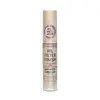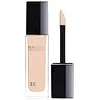What's inside
What's inside
 Key Ingredients
Key Ingredients

 Benefits
Benefits

 Concerns
Concerns

 Ingredients Side-by-side
Ingredients Side-by-side

Water
Skin ConditioningDimethicone
EmollientIsododecane
EmollientC13-15 Alkane
SolventPhenyl Trimethicone
Skin ConditioningSilica
AbrasiveButylene Glycol
HumectantIsobutylmethacrylate/Bis-Hydroxypropyl Dimethicone Acrylate Copolymer
Cetyl PEG/PPG-10/1 Dimethicone
EmulsifyingC30-45 Alkyl Dimethicone
Skin ConditioningQuaternium-90 Bentonite
Sorbitan Sesquioleate
EmulsifyingSodium Chloride
MaskingPhenoxyethanol
PreservativeDimethicone Crosspolymer
Emulsion StabilisingTriethyl Citrate
MaskingTocopheryl Acetate
AntioxidantEthylhexylglycerin
Skin ConditioningMethicone
EmollientHydrolyzed Hibiscus Esculentus Extract
Skin ConditioningDextrin
AbsorbentLecithin
EmollientPolyhydroxystearic Acid
EmulsifyingPentaerythrityl Tetra-Di-T-Butyl Hydroxyhydrocinnamate
AntioxidantEthylhexyl Palmitate
EmollientIsopropyl Myristate
EmollientIsostearic Acid
CleansingPolyglyceryl-3 Polyricinoleate
EmulsifyingSodium Hyaluronate
HumectantCI 77891
Cosmetic ColorantCI 77492
Cosmetic ColorantCI 77491
Cosmetic ColorantCI 77499
Cosmetic ColorantWater, Dimethicone, Isododecane, C13-15 Alkane, Phenyl Trimethicone, Silica, Butylene Glycol, Isobutylmethacrylate/Bis-Hydroxypropyl Dimethicone Acrylate Copolymer, Cetyl PEG/PPG-10/1 Dimethicone, C30-45 Alkyl Dimethicone, Quaternium-90 Bentonite, Sorbitan Sesquioleate, Sodium Chloride, Phenoxyethanol, Dimethicone Crosspolymer, Triethyl Citrate, Tocopheryl Acetate, Ethylhexylglycerin, Methicone, Hydrolyzed Hibiscus Esculentus Extract, Dextrin, Lecithin, Polyhydroxystearic Acid, Pentaerythrityl Tetra-Di-T-Butyl Hydroxyhydrocinnamate, Ethylhexyl Palmitate, Isopropyl Myristate, Isostearic Acid, Polyglyceryl-3 Polyricinoleate, Sodium Hyaluronate, CI 77891, CI 77492, CI 77491, CI 77499
Water
Skin ConditioningC9-12 Alkane
SolventCaprylic/Capric Triglyceride
MaskingPropanediol
SolventGlycerin
HumectantPolyglyceryl-6 Polyricinoleate
EmulsifyingDicaprylyl Ether
EmollientPentylene Glycol
Skin ConditioningSilica
AbrasivePolyglyceryl-10 Decaisostearate
EmollientSynthetic Fluorphlogopite
Trimethylsiloxysilicate
EmollientIris Florentina Root Extract
MaskingPolyglyceryl-2 Isostearate
EmulsifyingDisteardimonium Hectorite
StabilisingSodium Myristoyl Glutamate
CleansingStearalkonium Hectorite
Gel FormingSodium Chloride
MaskingButylene Glycol
HumectantLecithin
EmollientHydroxyacetophenone
AntioxidantSodium Benzoate
MaskingPropylene Carbonate
SolventPolyhydroxystearic Acid
EmulsifyingHydrolyzed Viola Tricolor Extract
Skin ProtectingAluminum Hydroxide
EmollientParfum
MaskingTocopherol
AntioxidantIsostearic Acid
Cleansing1,2-Hexanediol
Skin ConditioningCaprylyl Glycol
EmollientPolyglyceryl-3 Polyricinoleate
EmulsifyingAchillea Millefolium Extract
CleansingXanthan Gum
EmulsifyingTropaeolum Majus Flower/Leaf/Stem Extract
Skin ConditioningCitric Acid
BufferingPotassium Sorbate
PreservativeCI 77891
Cosmetic ColorantCI 77491
Cosmetic ColorantCI 77492
Cosmetic ColorantCI 77499
Cosmetic ColorantWater, C9-12 Alkane, Caprylic/Capric Triglyceride, Propanediol, Glycerin, Polyglyceryl-6 Polyricinoleate, Dicaprylyl Ether, Pentylene Glycol, Silica, Polyglyceryl-10 Decaisostearate, Synthetic Fluorphlogopite, Trimethylsiloxysilicate, Iris Florentina Root Extract, Polyglyceryl-2 Isostearate, Disteardimonium Hectorite, Sodium Myristoyl Glutamate, Stearalkonium Hectorite, Sodium Chloride, Butylene Glycol, Lecithin, Hydroxyacetophenone, Sodium Benzoate, Propylene Carbonate, Polyhydroxystearic Acid, Hydrolyzed Viola Tricolor Extract, Aluminum Hydroxide, Parfum, Tocopherol, Isostearic Acid, 1,2-Hexanediol, Caprylyl Glycol, Polyglyceryl-3 Polyricinoleate, Achillea Millefolium Extract, Xanthan Gum, Tropaeolum Majus Flower/Leaf/Stem Extract, Citric Acid, Potassium Sorbate, CI 77891, CI 77491, CI 77492, CI 77499
 Reviews
Reviews

Ingredients Explained
These ingredients are found in both products.
Ingredients higher up in an ingredient list are typically present in a larger amount.
Butylene Glycol (or BG) is used within cosmetic products for a few different reasons:
Overall, Butylene Glycol is a safe and well-rounded ingredient that works well with other ingredients.
Though this ingredient works well with most skin types, some people with sensitive skin may experience a reaction such as allergic rashes, closed comedones, or itchiness.
Learn more about Butylene GlycolCi 77491 is also hydrated iron III oxide. It's sole purpose is to give a red/pink hue to products.
Iron III oxides are classified as inorganic chemicals for coloring.
Synthetically created Ci 77491 is considered safer than those naturally found. This is because the synthetically created version may contain less impurities. Iron oxides are generally non-toxic and non-allergenic.
Learn more about CI 77491Ci 77492 is also hydrated iron III oxide. It's sole purpose is to give a yellow hue to products.
Iron III oxides are classified as inorganic chemicals for coloring.
Synthetically created Ci 77492 is considered safer than those naturally found. This is because the synthetically created version may contain less impurities. Iron oxides are generally non-toxic and non-allergenic.
Learn more about CI 77492Ci 77499 is also hydrated iron III oxide. It is created from mixing red and black iron oxides. This helps give shades of darkness to a product.
Iron III oxides are classified as inorganic chemicals for coloring.
Ci 77891 is a white pigment from Titanium dioxide. It is naturally found in minerals such as rutile and ilmenite.
It's main function is to add a white color to cosmetics. It can also be mixed with other colors to create different shades.
Ci 77891 is commonly found in sunscreens due to its ability to block UV rays.
Learn more about CI 77891Isostearic acid is a saturated fatty acid. Its structure makes it a great surfactant.
Surfactants help decrease the surface tension between two liquids. This property also makes it an effective emulsifier. Emulsifiers help prevent waters and oils from separating in a product.
Isostearic Acid is created from oleic acid.
This ingredient may not be Malassezia folliculitis, or fungal-acne safe.
Learn more about Isostearic AcidLecithin is a term for a group of substances found in the cell membranes of plants, animals, and humans. They are made up of mixture of phospholipids.
This ingredient has emollient and emulsifying properties.
As an emollient, lecithen helps soften the skin and creates a barrier to keep moisture in.
As an emulsifier, it also helps prevent water and oil ingredients from separating. Lecithin can also help ingredients be better absorbed by the skin.
This is because the phospholipids in lecithin produce liposomes. Liposomes help other ingredients get through the skin barrier.
Depending on the source of this ingredient, lecithin may not be fungal acne safe. This is because some sources of lecithin come from soybean oil, which may feed the malassezia yeast that feeds fungal acne.
We recommend reaching out to the brand you are purchasing from to inquire about the source of their lecithin.
Some other names for this ingredient include soy lecithin and deoiled soy lecithin.
Learn more about LecithinThis ingredient is an emulsifier. It is created from Polyglycerin-3 and Ricinoleic Acid.
As an emulsifier, it prevents waters and oils from separating. According to a manufacturer this ingredient is fully biodegradable.
This ingredient may not be safe for Malassezia folliculitis due to its Ricinoleic Acid base. Ricinoleic Acid is a fatty acid derived from castor oil.
Learn more about Polyglyceryl-3 PolyricinoleatePolyhydroxystearic Acid is a soft wax made from castor oil.
It is is a texture thickener, emulsifier, and film-former. Emulsifiers prevent ingredients from separating, such as oils and waters.
Polyhydroxystearic Acid may not be fungal acne safe.
Learn more about Polyhydroxystearic AcidSilica, also known as silicon dioxide, is a naturally occurring mineral. It is used as a fine, spherical, and porous powder in cosmetics.
Though it has exfoliant properties, the function of silica varies depending on the product.
The unique structure of silica enhances the spreadability and adds smoothness, making it a great texture enhancer.
It is also used as an active carrier, emulsifier, and mattifier due to its ability to absorb excess oil.
In some products, tiny microneedles called spicules are made from silica or hydrolyzed sponge. When you rub them in, they lightly polish away dead skin layers and enhance the penetration of active ingredients.
Learn more about SilicaChances are, you eat sodium chloride every day. Sodium Chloride is also known as table salt.
This ingredient has many purposes in skincare: thickener, emulsifier, and exfoliator.
You'll most likely find this ingredient in cleansers where it is used to create a gel-like texture. As an emulsifier, it also prevents ingredients from separating.
There is much debate on whether this ingredient is comedogenic. The short answer - comedogenic ratings don't tell the whole story. Learn more about comegodenic ratings here.
The concensus about this ingredient causing acne seems to be divided. Research is needed to understand if this ingredient does cause acne.
Scrubs may use salt as the primary exfoliating ingredient.
Learn more about Sodium ChlorideWater. It's the most common cosmetic ingredient of all. You'll usually see it at the top of ingredient lists, meaning that it makes up the largest part of the product.
So why is it so popular? Water most often acts as a solvent - this means that it helps dissolve other ingredients into the formulation.
You'll also recognize water as that liquid we all need to stay alive. If you see this, drink a glass of water. Stay hydrated!
Learn more about Water